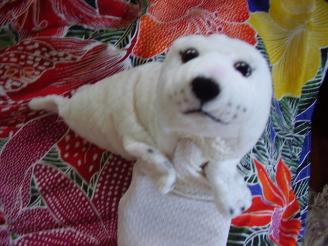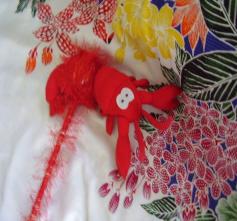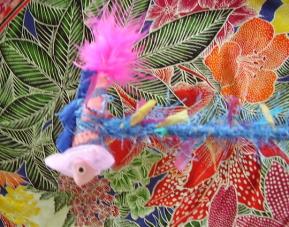Ya HUH!
Just because I got off the ship in May doesn't mean my job is over. Actually this is when all the REAL fun begins. This is where I begin to tell my story.
I missed my dear students so much while on the mission. When we were united on May 16, I had so many aloha hugs. It was a block day, so I got to talk story with each of my classes for 70 minutes, share root beer floats (I promised) and give them the IPY Webinar of Marine Mammals. My dear substitute teacher had all 6 of my classes compete to create the BEST welcome back poster so the back of my room was a wash with color! An added bonus was the neatness of my classroom. I saw the top of my demonstration table for the first time since last July, IMAGINE!
The next week, our morning broadcast director asked me to create a slide show and be interviewed for the show. The interview went great as it was piped to all 1000 Kalama folk, and the slides spoke for themselves over the TV. I wrote a story for the Monthly newsletter informing all the upcountry community of my willingness to come talk story with them or their class/business. In early June, I presented at the last PTA meeting of the year.
All that was just the warm up act for what I truly love to do, write curriculum to help others learn. I have so much to tell!
I wrote a TRIBES lesson "Novel in an Hour" in which a class reads one whole chapter of a multi chapter book, then presents their chapter to the rest of the class. The class ends up reading a whole book by learning from other groups that read it and present it in tweenage style. The book we read was called "Goodbye, My Island" and it is written from the viewpoint of a 12 year old girl during her last winter on King Island in the Bering Sea. The seal team from the Healy helped me out as they were JUST passing King Island as we were reading the book. They sent me pictures of the now deserted island. How cool is that!
I wrote stations that are set up during my slide presentations. Many of the groups that I plan to present to are young and active. I need a variety of activities to do, while I talk. So the stations I have available are 1. Making an albatross paper airplane 2. Drawing a humpback whale 3. Writing a hypothesis as to what they think will happen to a shrunken ringed seal that I place in a bucket full of room temperature water 4 Dressing up Hawaiian paper dolls, first for a swim in the ocean in Hawaii, then for playground fun in Alaska in winter 5. Making a diatom bookmark 6 Learning Inupiat words for parts of a whale.

I made all sorts of Bering Sea animal puppets from socks and stuffed animals. This is a baby ribbon seal puppet
I also have animal puppets that I set around the stations with little cards that explain what they are and their place in the ecosystem.
I wrote several lyrics that go along with familiar songs. In the song "The Ice Algae Grows Underneath of the Ice" (sing to the tune "The Green Grass Grew all Around") I made many puppets of ice algae, krill,

Lobster puppet on a stick
copepods, seals, whales, fish

Baby pollack on a stick. Note the three humps on the dorsal fin.
and birds so students jump up when their creature is sung and then sit down when the stanza is done. For the song "The Algae in the Ice" (sung to the tune "The Farmer in the Dell") I created a similar format with puppets to match. We cannot leave out "Without Guano There's No Life" (sung to "You are the Sunshine of my Life").
I created a card game and sent it off to NOAA Alaska Fisheries in Seattle based on collector cards of creatures that inhabit the North Pacific ecosystem called "The Fabulous Food Chain Game" I had to create a few new cards of my own and my students will have fun playing it this late summer as we start school in just two days!
I wrote a new play "The Heart of the Albatross" and will be putting it on with my team for Earth Day Activities in April in our cafetorium. Everyone is welcome to attend. My students will also be leading you through other learning stations that they create in the perimeter around the space. It is a way that my students can lead others to understanding more about our one ocean one earth.
I am writing curriculum that (hopefully) will be funded through a grant from University of Hawaii (CMORE program). It is a series of lessons that have my students connecting mo'olelos (folk stories) to explaining natural phenomenon and comparing it to the scientific method. Then they look at the role and importance of art in science (scientific illustration)as we model drawing phytoplankton in the style of Earnst Haeckle. Next we look at creating a protocol to collect phytoplankton around our island and create a database of what we found. We will create and make our own phytoplankton nets so that we can do that. And hopefully have a field trip down to the ocean so that we can do initial collecting.
I am hoping that some classes in Alaska (in the Pribilof Islands) and others will take me up on becoming 'sistah schools' and do the same lessons that we do in this project and then swap observations, and questions, hopes and fears at a blogspace online. I am also hoping that there are lots of scientists in both of these areas to help us out identifying these tiny producers (diatoms, algae, protists et all).
Part of the 'sistah school' education will be the sending of a cultural crate to the school. In it, I hope students will make and include 'stuff' that they believe helps others to understand their culture. Possible items will include carvings, videos of hulas, artwork, books, pictures, food, the possibilities are endless!
We are going to learn about tagging and tracking animals using gps from following the seals that were tagged on the BEST mission and afterwards by the NOAA NMML Seal Team and hope to connect with the Hawaiian Monk Seal research to compare and contrast what is happening with these wonderous phocids. Anothe scientist onboard the Healy tagged beautiful albatross this summer and we will be following their motions as well. These lessons I have yet to develop, but reading what I have done so far, I hope you can understand.
Lastly I have created a book of my wonderous travels. It is just for me, but I can take it along to have others read it. It is based around a sestina. Sestinas were used by troubadors in the 12th-15th century as a way to tell a story. It is a poem, that uses a distinct word formula. Six words that end the first six lines of the poem are used in the six stanzas of the poem, in a specific order. Just google sestina and you will have an idea of what it is. I added pictures of my adventure and have it color copied through our business copy shop. There you go.
I am not finished with telling my story as you can see, and I hope you will continue to follow my adventures as my students and I begin to help you understand that it really is "One Ocean One Earth."
If you have any questions or want to learn more about the curriculum I have mentioned, PLEASE ask me a question under the 'ASK THE TEAM" portion of this mission. I will be sure to respond!
warmly and with much aloha,
Maggie


Comments